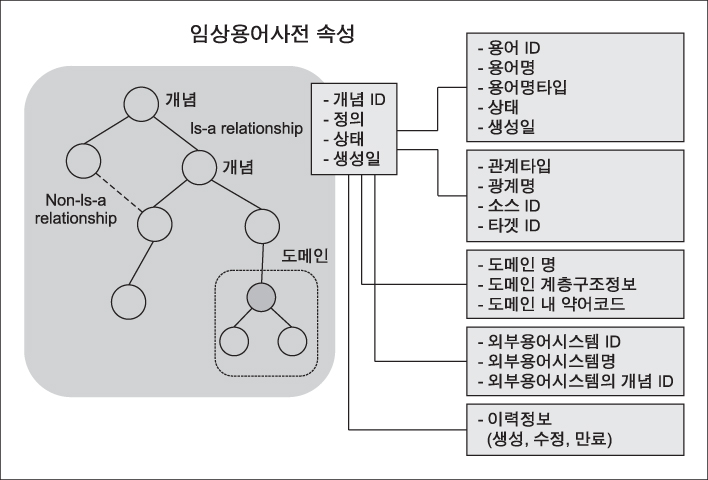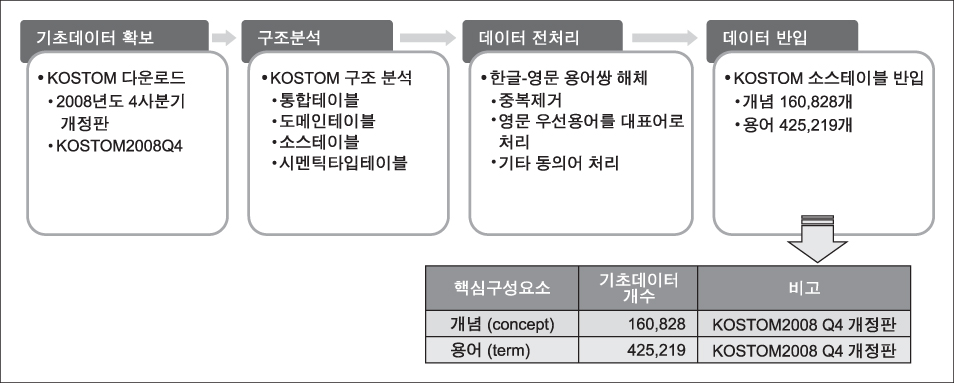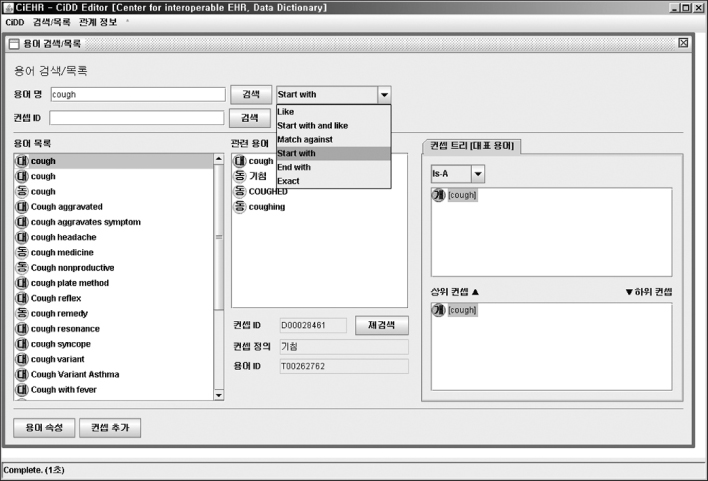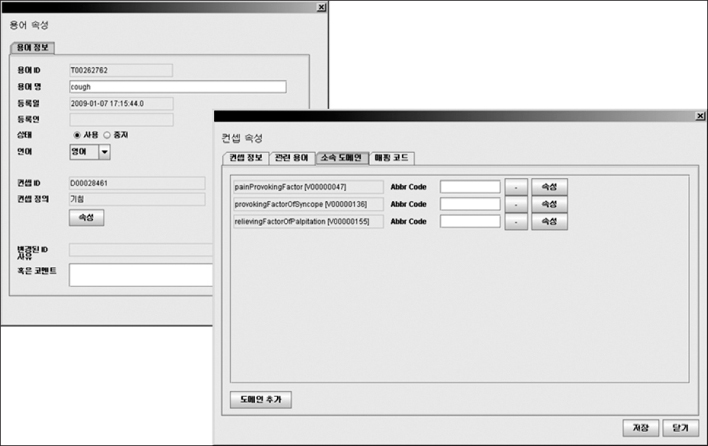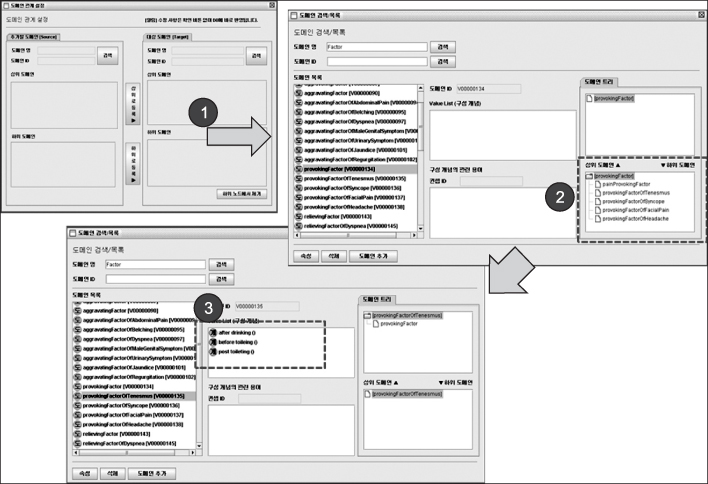J Korean Soc Med Inform.
2009 Dec;15(4):411-421.
The Development of Clinical Terminology Dictionary for Integration and Management of Clinical Terminologies in EMR Systems
- Affiliations
-
- 1R&D Center for Interoperable EHR, Korea. april0149@gmail.com
- 2Department of Health Policy & Management, College of Medicine, Seoul National University, Korea.
- 3Institute of Health Policy & Management, College of Medicine, Seoul National University, Korea.
- 4Biomedical Knowledge Engineering Laboratory, Seoul National University, Korea.
Abstract
OBJECTIVE
The development of a dictionary of clinical terminology based on medical concepts is essential for understanding the precise meanings of the clinical terminologies used in EMR systems. For an unambiguous presentation and retrieval of the terminologies in practical data entry, this study propose a clinical terminology dictionary, which integrates and manages the wide range of data in EMR Systems. METHODS: The structure of the system and attributes were defined. The structures should satisfy the following: all terminologies should be consistent with the medical concepts, all concepts have multiple relationships, all concepts have many synonyms, all concepts can be mapped to concepts in an external medical terminology system, and all concepts can be grouped as value sets by setting the "domain". RESULTS: With the derived entity objects and attributes, the physical clinical terminology database was constructed and an editor was developed using MySQL 5.0.45 and JAVA Swing. To verify the structure and contents of the developed clinical terminology dictionary, the terminology experts used the editor to search and register the medical concepts. CONCLUSION: Although the contents refinement and complements are an unsolved problem, it is anticipated that the proposed research will provide unambiguous meanings of the clinical terminology and be applicable to many services in EMR systems.
Figure
Reference
-
1. Rector A. Coordinating Taxonomies: key to re-usable concept representations. Artif Intell Med. 1995. 17–28.
Article2. Cimino JJ, Patel VL, Kushniruk AW. Studying the human computer-terminology interface. J Am Med Inform Assoc. 2001. 8(2):163–173.3. Huanying G, Michael H, James G, Yehoshua P. Benefits of an Object-oriented database representation for controlled medical terminologies. J Am Med Inform Assoc. 1999. 6:283–303.
Article4. Campbell KE, Cohn SP, Chute CG, Rennels G, Shortliffe EH. Ga'lapagos: computer-based support for evolution of a convergent medical terminology. Proc AMIA Annu Fall Symp. 1996. 269–273.5. Oliver DE, Shahar Y. Development of a change model for a controlled medical vocabulary. Proc AMIA Annu Fall Symp. 1997. 605–609.6. Rosenbloom ST, Miller RA, Johnson KB, Elkin PL, Brown SH. Interface terminologies: facilitating direct entry of clinical data into electronic health record systems. J Am Med Inform Assoc. 2006. 13(3):277–288.
Article7. Rocha RA, Huff SM, Haug PJ, Warner HR. Designing a controlled medical vocabulary server: the voser project. Comput Biomed Res. 1994. 27:472–507.
Article8. Cimino JJ. From Data to knowledge through concept-oriented terminologies: experience with the medical entities dictionary. J Am Med Inform Assoc. 2000. 7(3):288–297.
Article9. Dolin RH, Alschuler L, Boyer S, Beebe C, Behlen FM, Biron PV, et al. HL7 clinical document architecture, release 2. J Am Med Inform Assoc. 2006. 13(1):30–39.
Article10. HL7 Clinical Document Architecture Release 2.0. http://www.hl7.org/Library/standards_non1.html#CDA.11. Coyle JF, Mori AR, Huff SM. Standards for detailed clinical models as the basis for medical data exchange and decision support. Int J Med Inform. 2003. 69(2):157–174.
Article14. http://metadata-standards.org/Participate/Conferences/openforum1999/presentations/USHIKDR7b.ppt.16. Cimino JJ. Desiderata for controlled medical vocabularies in the 21st century. Method Inf Med. 1998. 37(4-5):394–403.17. KOSTOM. http://www.medistds.or.kr/ehealth/index.jsp.18. McDonald CJ. The barriers to electronic medical record systems and how to overcome them. J Am Med Inform Assoc. 1997. 4(3):213–221.
Article19. Chute CG. Clinical Classification and terminology: some history and current observations. J Am Med Inform Assoc. 2000. 7(3):298–303.
Article20. Chute CG. The copernican era of healthcare terminology: a re-centering of health information systems. Proc AMIA Symp. 1998. 68–73.21. Haux R. Health information systems-past, present, future. Int J Med Inform. 2006. 75:268–281.22. Reichertz PL. Hospital information systems-past, present, future. Int J Med Inform. 2006. 75:282–299.
Article23. Columb RM. Impact of semantic heterogeneity on federating databases. Comput J. 1997. 40:235–244.
Article24. Heiler S. Semantic interoperability. ACM Comput Surv. 1995. 27:271–273.
Article
- Full Text Links
- Actions
-
Cited
- CITED
-
- Close
- Share
- Similar articles
-
- Clinical Terminologies: A Solution for Semantic Interoperability
- On Anatomical Terminologies in the Index of the three Whole Body Figures of De Humani Corporis Fabrica Liber Primus
- Study on the Differences between High School Biology Textbook Terminologies and Official Terminologies of Histology or Embryology
- Computer for the Learning of Korean Medical Terminology
- Study on the Differences of Anatomical Terminologies between Korean Association of Anatomists and Korean Association of Biological Sciences


